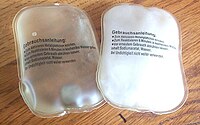
Photo from wikipedia
Metal-ion hybrid supercapacitors (MICs) are a new type of electrochemical energy storage (EES) device, consisting of a battery-type electrode and a supercapacitor (SC)-type electrode. Exhibiting the advantages of both batteries… Click to show full abstract
Metal-ion hybrid supercapacitors (MICs) are a new type of electrochemical energy storage (EES) device, consisting of a battery-type electrode and a supercapacitor (SC)-type electrode. Exhibiting the advantages of both batteries and SCs (e. g., good energy density, excellent power density and long cycle life), these advanced energy storage devices have considerable commercial application prospects. Among MICs, potassium-ion hybrid supercapacitors (PICs) have several further advantages, including abundancy of resources, low standard electrode potential, and low cost. PICs are regarded as potential substitutes for lithium- or sodium-ion hybrid supercapacitors. However, the practical applications of PICs remain limited, owing to the imbalance of kinetics and capacity between the electrodes, the slow ion/electron diffusion rate, and the poor electrode structural stability. Recently, 2D materials with distinct structures and fascinating features have elicited widespread attention for application in PICs, thus achieving significant enhancements, ranging from charge storage capacity to reaction kinetics. This Review discusses research progress in 2D materials for PICs. Firstly, the energy storage principle and development requirements of MICs are introduced. The pivotal advantages and significant roles of 2D materials in the fabrication of PICs are then discussed in detail. Lastly, the challenges and prospects of the application of 2D materials to high-performance PICs are presented.
Journal Title: ChemSusChem
Year Published: 2021
Link to full text (if available)
Share on Social Media: Sign Up to like & get
recommendations!